
Final Fantasy VII: Ever Crisis Closed Beta Test Impressions: an extensive deep dive into how everything works in FF7 Ever Crisis
Last month, James was able to check out a bit of Final Fantasy VII: Ever Crisis, the new mobile game that’s entirely focused around anything and everything FF7. It aims to bring the entirety of the Compilation of Final Fantasy VII to modern audiences under one game. I recently got accepted into its limited-time closed beta test and put a lot of hands-on time into it to learn exactly what’s going on with this project.
Let’s set expectations here first. This is a free-to-play mobile game with a gacha system. You don’t roll for characters, but you do roll for their unique weapons under a set probability. The monetization plans for Ever Crisis are crystal clear as players will be able to buy the currency needed for rolls with real money.
It remains to be seen how predatory this game will be with its full release, since the option to buy the gacha currency directly was not available in this closed beta. As with other mobile gacha games, this aspect is tricky to gauge until the full game has been out for a few months, because we've yet to see how often this gacha currency will be given away through login campaigns, doing daily & weekly tasks consistently, first-time completion rewards, how much in-game events will give out, and so on. I’ll go into the specifics of how the gacha system works later, because it’s more complex than you’d expect and it heavily intertwines with how character progression is handled.
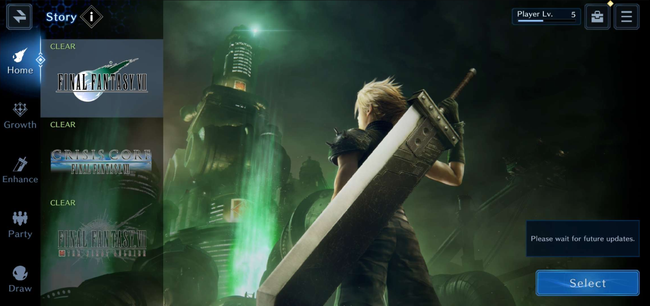
Three FF7 series were included in the closed beta - the original Final Fantasy VII, Crisis Core, and The First Soldier. You unlock these series sequentially, so you go through the first chapter of FF7, unlock Crisis Core, finish Crisis Core’s first chapter, and then unlock The First Soldier.
Don’t expect an in-depth complete retelling when it comes to these stories; they’re all served up as bite-sized chunks that go over the significant events of each series. In The First Soldier’s case, it’s pretty much all brand-new, because it tells a narrative revolving around three of SOLDER’s P0 Class - Glenn, Lucia, and Matt. They were seen in the opening movie of The First Soldier when that was still in service (it has since shut down), but obviously the battle royale experience was the core focus of that game.
Initially, only the first chapter of Final Fantasy VII was offered when the closed beta launched. A recent update added its second chapter.
To paint a picture of what the story pacing is like in Ever Crisis, FF7’s first chapter covers the beginning of the game up until the first fight with Reno at the church. It begins with the famous bombing mission of Mako Reactor 1 and tugs on the heartstrings of those that have played the original PS1 version. Unlike FFVII Remake, a few of Ever Crisis’s stages have an explorable space that mimics the original Final Fantasy VII, with fixed camera angles and random encounters. The character models here aren’t quite as blocky as the PS1 models; they’re closer to the chibi models found in Dissidia Final Fantasy: Opera Omnia.
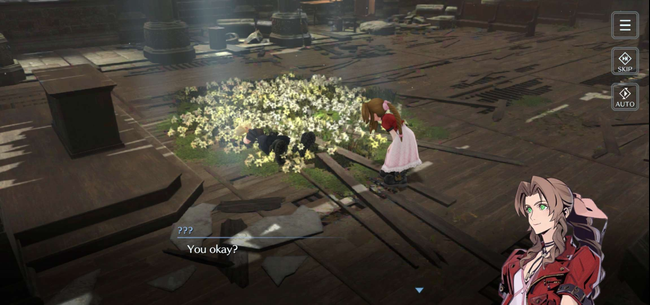
Once again, although the maps do mimic the original layout though, it’s a more condensed version of it. In the opening act, players start at the train station and go through the first gate that the other members of Avalanche unlock. Shortly after, they’ll find themselves at the familiar T-section platform leading into the mako reactor. Then once Cloud enters it, players will be immediately transported into the “final” section of that mako reactor with the gigantic room with ladders leading to the landing where Cloud plants the bomb and faces off against the Guard Scorpion with Barret.
Players manually move Cloud around in these parts, and sometimes a branching path may lead to a treasure chest. Unlike the original and remake, these chests in Ever Crisis contain something far more valuable than potions - gacha currency in the form of blue crystals and draw tickets. Players don’t have to worry about managing consumable items in these explorable parts with random encounters, since the party will fully heal themselves after every fight.
After Mako Reactor 1’s destruction, the next story node covers Cloud’s first encounter with Aerith and a brief fight with Shira soldiers as he makes his way through Sector 5. There’s no explorable space - just some small character interactions into a quick fight. That’s how most of the story is presented in Ever Crisis; the sections that allow players to move around with a character are disappointingly few and far between. Crisis Core and The First Soldier each have a single story section so far that allows players to move around an environment, too.
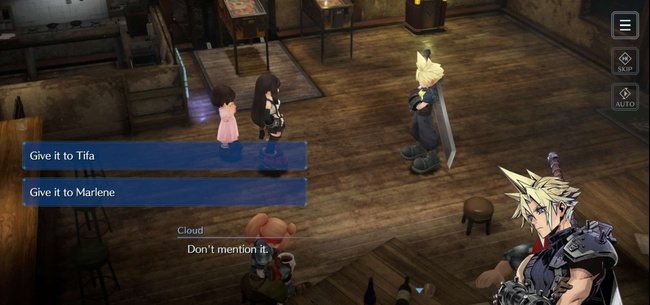
There are also story-only nodes that just have characters speaking with one another until the next big development in the story. A small, interesting thing that Ever Crisis allows for is small alterations to the flavor of its dialogue based on prior player decisions. For instance, players are given the option of whether they want to accept the flower that Aerith offers in their first meeting. If he does take it from her, that flower can either be given to Tifa or Marlene when Cloud arrives at Seventh Heaven. Giving the flower to Marlene has her remark that Cloud gave it to her when Barret arrives shortly after and this small interaction doesn’t happen at all if Cloud rejected the flower from Aerith in the prior story node. It’s a small thing that doesn’t change anything significant, but it helps give the story a tiny bit of flavor in an otherwise straightforward, abridged retelling.
The Whispers don’t show up at all either during the events of FF7 in Ever Crisis, so it’s safe to assume that it is adapting the original instead of the remake as well.
Another thing that Ever Crisis does with its retelling of FF7 is include sub-sections during the main narrative. These effectively serve as mandatory side-stories that focus on a side character or side activity. The first instance of these is a trio of story nodes that focus on Biggs, Wedge, and Jessie respectively. They are stories that flesh these characters out a tiny bit, such as Wedge’s fondness for Candy the cat, or Jessie trying to hack through Shinra’s firewalls.
Once that’s wrapped up, it’s back to the main story with bombing Mako Reactor 5, facing off against the Airbuster, Cloud falling into the church, speaking with Aerith, and then beating up Reno. Chapter 2 covers meeting Aerith’s mom, the events at Wall Market, heading back to Sector 7, and the second showdown with Reno. No new explorable story nodes in chapter 2 unfortunately.
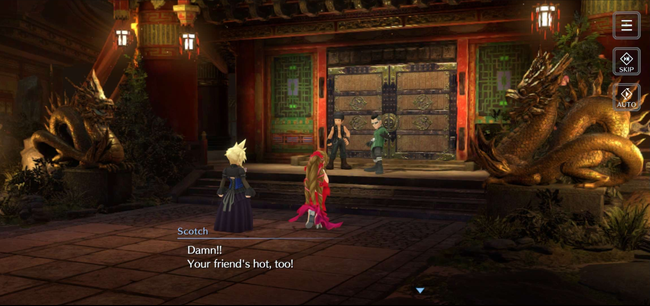
Those hoping for fully-voiced story scenes won't be happy. Leaning more on the original PS1 release, character interactions are all unvoiced and battles will be the bulk of where the voice acting bits are. On the flip side, the OST for Ever Crisis is outstanding as it contains new delightful arrangements for some of the most memorable tunes in Final Fantasy history.
So hopefully that paints a clearer picture of what to expect from the story pacing for the original FF7 in Ever Crisis. In a Famitsu interview back in March 2021, Tetsuya Nomura commented that chapter 3 will cover the escape from Midgar and that the entire FF7 story will span ten chapters in Ever Crisis. According to what Square Enix PR told James last month, “the original Final Fantasy VII story content will be available in its entirety at launch”. None of the story content in Ever Crisis consumes stamina; only enhancement quests for obtaining weapon materials, grinding character EXP, and other non-story stuff do. The game even allows “stamina boosts”, which consume three times as much stamina in a previously completed quest to earn three times the rewards.
Now here’s the catch. Story stages ramp up in difficulty. Fast.
Every stage that contains a battle in Ever Crisis has a recommended power level number. Players aren’t required to meet it, but it’s a quick glance at how hard they can expect the stage to be. There are noticeably drastic difficulty spikes later on in chapter 2 of FF7. Story stages also normally lock players to a set party because of what’s going on in the narrative so sometimes it’ll only be Cloud/Barret, or Cloud/Aeirth, or Cloud/Tifa/Barret going into a given stage. There is a “free party” mode to allow for outside characters to complete a stage, but no completion rewards will be given for doing so.
This is what makes going through Crisis Core a somewhat challenging prospect too because well, Zack is the only character available for that.
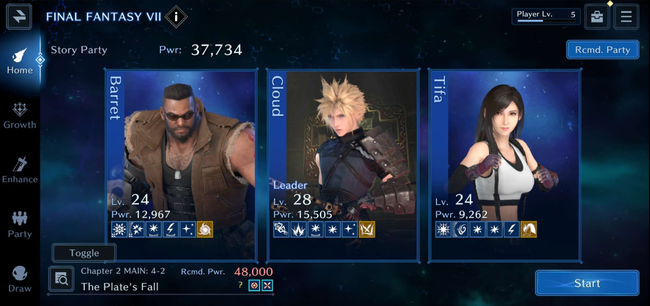
Going through the story won’t be a walk in the park in Ever Crisis; it’s a game people will have to grind to overcome difficulty spikes, especially with the story-locked parties if they want to obtain all the story’s completion rewards. Prepare to invest in building up multiple characters and tinkering with party configurations quite a bit. Even though people deploy locked preset characters in story stages, they can alter their equipment and ability loadout. I’ll go into that much more in-depth later, but keep that in mind for now.
I don’t consider any of this necessarily bad. I was more caught off-guard because I didn’t go out of my way to grind my characters vigilantly, since it’s a closed beta test that will have all of its data wiped before the full release.
With that said, this is the perfect time to talk about how character-building is handled in Ever Crisis and how the battle system is linked to it. There’s a lot going on.
In our last preview of Ever Crisis, James provided a basic rundown of how combat was presented. Players can have up to 3 party members out and all of them have an ATB gauge that’s constantly filling up. Basic attacks are done automatically and don’t consume ATB, while the five commands underneath the gauge do. Simple enough.
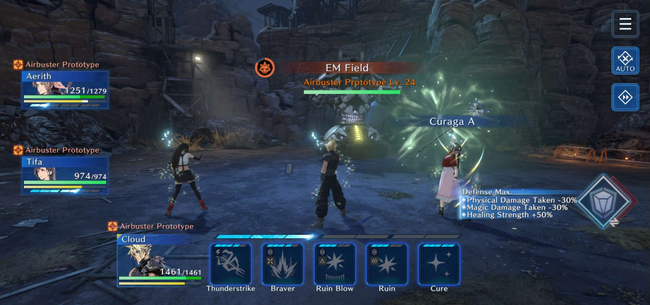
Plus, players can toggle between a defense (blue) and offense (red) stance for the entire party. The defense stance decreases the amount of incoming damage the party takes; it also increases the potency of all healing spells cast when this stance is active. Meanwhile, the offense stance, as you might expect, buffs all the damage you’re dealing while in it.
There is something special about the offense stance too. Sometimes, unique enemies and bosses go into a “countdown” phase where they begin to wind-up for a big attack. It’s indicated at the top of the screen along with a symbol and a number beneath. For example, the Guard Scorpion might be preparing for a huge laser attack, and underneath it is a triangle and a 16. Normally, hitting the Guard Scorpion in this phase with abilities will deplete that number by 1. Some weapon abilities and materia are specialized to deal bonus “sigil damage” to the triangle symbol though and hitting the Guard Scorpion with skills that deal bonus damage to the triangle symbol can knock that number down by 2 or 3 instead, thus speeding up the process to neutralizing that big attack from coming out.
This mechanic is used in creative ways; it’s not just for canceling incoming attacks. In the second fight with Reno in FF7’s story, he has the ability to seal a character inside a pyramid. The sealed character can’t do anything, so the other 2 characters have to work on breaking two different symbols to unseal that party member as soon as possible.
These different ways to utilize this system make me excited to play with friends in multiplayer, which Ever Crisis does support. Up to 3 different people can party up to tackle bosses; this feature was only available during certain time slots in the closed beta and I couldn’t find anyone when attempting to find players the few times I tried sadly.
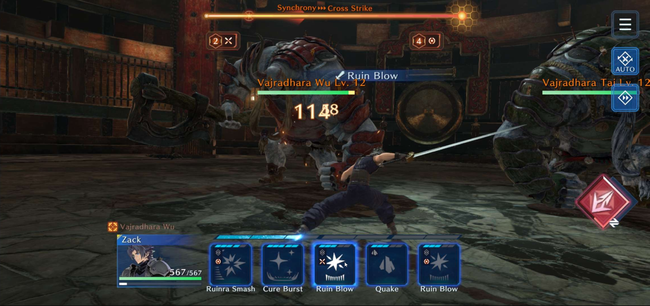
Although the battle system has a few neat ideas up its sleeve, there’s little reason to not just turn on auto-battle - at least for a lot of the early content presented in closed beta. The auto-battle function comes in two modes: semi and full auto. Semi will automatically use the appropriate skills when a character has enough ATB gauge, while full auto will also automate stance switching as well.
In practice, the full auto mode will continually target an enemy’s weakness if a character was set with a weapon ability or materia spell that targets it. Full auto maximizes the amount of attacks fired off in the offense stance as it switches to defense stance right before a big attack is fired off. The feature remembers to switch to defense stance any time a character is about to cast a healing ability and immediately switches back to offense stance right after. Have something that does bonus sigil damage? Full auto will make sure to spam it during the enemy’s “countdown” phase. Ever Crisis’s battles can be set to double speed, so full auto can fully keep up with the increased pace. The only thing players ever have to do manually is fire off a character’s Limit Break.
The only time auto-battle failed me was for challenging content that was way above my party’s power level. Its priority to optimize damage output meant that my healer kept firing off other attack spells, instead of solely focusing on just healing.
Ultimately, it’s probably good that the auto-battle does work as well as it does. It helps automate and speed up a lot of the grind because if it was substantially worse, manually playing every single battle in this game will inevitably be tedious as time goes on. If the challenging content remains at a point where auto-battle just barely isn’t good enough at times, it probably ends up being more approachable and tolerable overall.
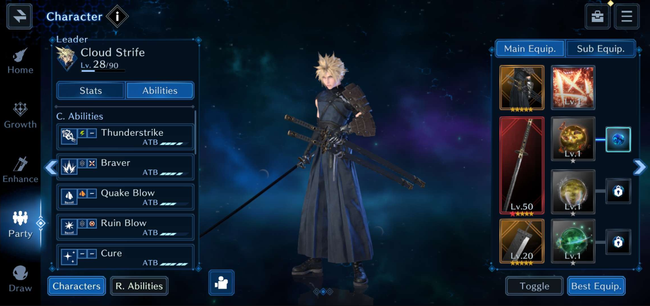
With that all laid out, let’s get into building parties in Ever Crisis.
Characters have a lot of things that can be put on them - a costume, a main weapon, a sub-weapon, a Limit Break, three materia, and three “secondary” sub-equipment weapons.
I’ll talk about costumes in a little bit so let’s focus on the rest.
Weapons have three important aspects to them aside from their stats: core abilities, reinforcement abilities, and support materia. A core ability is the unique ability assigned to that weapon. Reinforcement abilities provide secondary passives to a character. For instance, Cloud’s Murasame has Thunderstrike as its core ability, while Physical Strength Up and Lightning Potency Up are its reinforcement abilities. Each reinforcement ability is assigned a predetermined amount of points, which will become important in just a bit. Lastly, support materia provides further stat enhancements for the weapon as they’re unlocked but more importantly, this is where it indicates which sigil a weapon can deal bonus damage to. These can’t be changed on weapons, but it can be altered for materia.
Both a main and sub-weapon’s core abilities are slotted into the first two slots of a character’s ATB command list in battle. Both weapons’ reinforcement abilities are equipped onto the character too, but it is heavily affected by whether it is a main or sub-weapon.
Remember the points I mentioned earlier for reinforcement abilities? These dictate their level. The Murasame’s Physical Strength Up reinforcement ability is worth 16 points. If I slot the Murasame as a main weapon, Cloud will gain a Level 3 Physical Strength Up reinforcement ability. On the other hand, if I put the Murasame as a sub-weapon, Cloud now only has a Level 2 in Physical Strength Up so his attack modifier has been decreased by this one small change. The difference between a Level 2 and Level 3 for Physical Strength Up is 40 to the physical attack - so it’s pretty substantial.
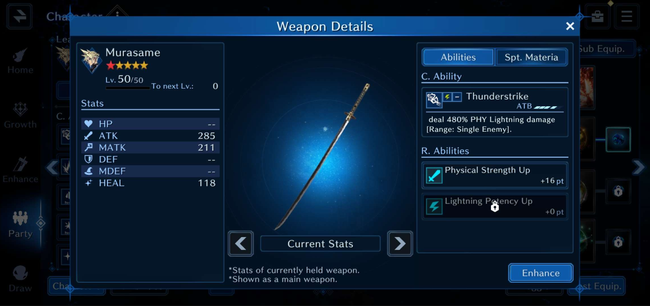
This is because equipping a weapon in the sub-weapon slot makes their reinforcement ability’s points half as effective. Level 1 reinforcement abilities mean that they’re worth between 1 to 4 points, level 2 is 5-14 points, and so on.
Both a character’s main and sub-weapon are locked to weapons exclusive to that character. Meanwhile, the three sub-equipment weapons lift that restriction and they can wear any of the cast’s weapons. Unlike the main and sub-weapons, a character cannot use the core ability of these secondary set of weapons but like the sub weapon, their reinforcement abilities can be put on albeit half as effective, so half their point worth.
To round out a character’s kit, the remaining three skill slots on their ATB command deck are all dictated by the three materia they equip. Building a party of three that synergizes with one another feels rewarding in Ever Crisis; each of the trio fills in the role and elemental gaps someone else isn’t able to provide.
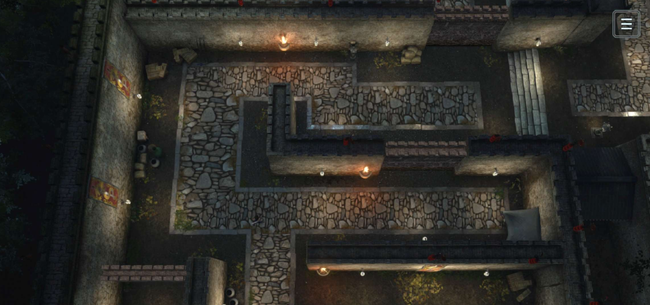
This leads me to one of the modes I enjoyed the most in Ever Crisis - the Criterion Dungeons. Think of these as remixes to the few explorable levels you encounter in story mode. These are not confined to story-locked characters, so players can bring their best team into them without any regard to narrative canon. These levels still contain the same map layouts as the original, but they contain new placements of previous bosses. Criterion Dungeons have a cruel gimmick as well; a percentage of any damage your characters incur will be deducted from their max HP.
Players can’t solely rely on outlasting their foes by spamming Curagas because the more damage they take, the less max HP their characters will have. There are a few temporary consumable items in chests that restore back max HP, so there is a bit of leniency for players. Some fun sub-objectives are contained in Criterion Dungeons, such as a Cactuar spawning in a certain part of the first area. It’ll flee quickly, so players have to be quick on eradicating it.
There is also a Tower mode that unlocks after completing chapter 1 of The First Soldier. This is your standard type of Tower mode that gets more and more difficult the higher (or in this case lower) you go. It rewards character shards that are used to further enhance a character’s stats.
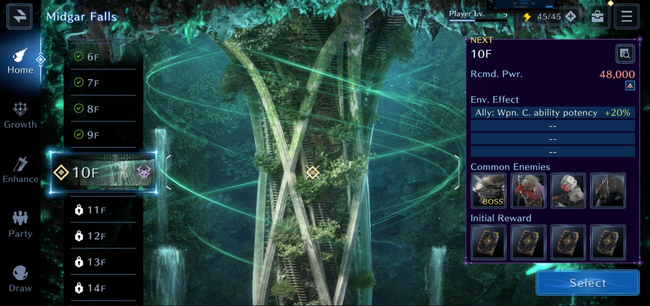
Of course, no deep dive into Ever Crisis is complete without mentioning its gacha system. Since so much of a character’s abilities and capabilities are dictated by their weapon setup, people will have to be vigilant in building a vast amount of weapons over time to keep their characters flexible not only for any challenging stamina-based content, but to push their respective series’ story as well. It’s inevitable that players will end up having to invest resources into the entire cast due to pushing their stories alone.
So like I mentioned earlier, Ever Crisis features a weapon gacha; the only things that come from a roll are 3-star, 4-star, and 5-star weapons. All weapons can eventually be upgraded to their 5-star versions by drawing duplicates of that specific weapon. Let’s say you roll a 3-star version of Tifa’s Leather Gloves. If you eventually draw her 4-star Leather Gloves, it’ll automatically upgrade its rarity and you won’t lose progress on any resources you’ve put into the 3-star version because it’s still the same Leather Gloves - just with its rarity automatically enhanced, so it’ll have better stats.
Now let’s say you get Aerith’s 3-star Silver Staff and you keep on rolling that same 3-star version of that weapon never receiving a higher rarity for it. Every duplicate of that 3-star Silver Staff is converted to Silver Staff weapon tickets and it takes 10 of those to upgrade it into a 4-star. It’ll take a whopping 200 Silver Staff weapon tickets to upgrade the 4-star to its 5-star version.
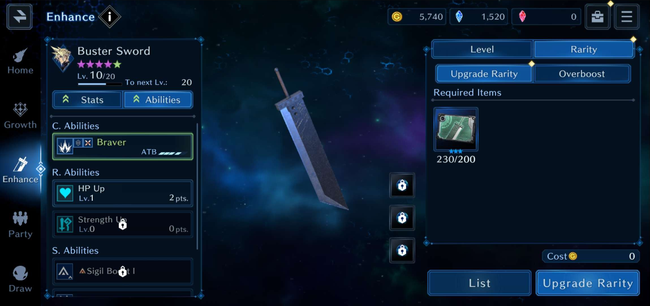
Rolling or upgrading to a 5-star version of a weapon vastly enhances not only its stats but transforms the weapon's ability into a better version of it. Cloud’s Buster Sword initially starts with Fast Blade and turns into Braver when it becomes a 5-star weapon.
Of course, the dopamine of increasing stats never really ends. Every 200 weapon tickets can “Overboost” a 5-star weapon which will further enhance its stats and weapon ability modifier.
So with the heavy reliance on building and upgrading a sizable roster of weapons for each character, you may be thinking what are the odds of rolling a 5-star weapon in the first place? The closed beta test for Ever Crisis has the 5-star SSR rate set at 7.5%, so at a glance it is somewhat higher than the average when placed against other mobile gacha games.
If you’re aiming for specific weapons though, the vast amount of weapons dilutes that percentage to a measly 0.10563% chance for rolling that specific weapon… normally. Don’t be too disheartened by seeing that absurdly low percentage because another aspect of the gacha system somewhat offsets it.
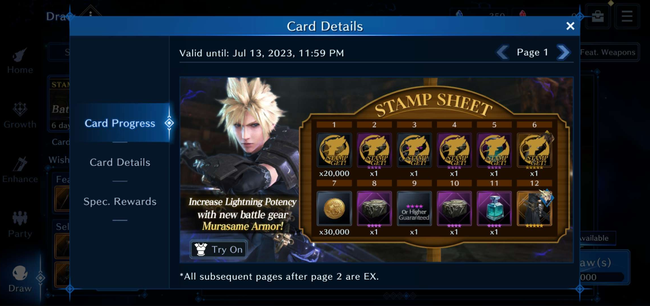
Much of Ever Crisis’s gacha system revolves around a stamp card mileage mechanic. Every time you do a 10-roll (not a single roll) on a specific stamp banner, you will earn at least one stamp. These stamps are useful because they can give you a sizable amount of gil, weapon mats, stamina-refilling potions, and so forth. Earning 6 stamps guarantees one of the two limited 5-star gacha-only weapons featured on the banner and people can set which weapon they want to receive beforehand.
In the closed beta, one of the banners contains Cloud’s Murasame and Barret’s Microlaser. Players can choose to either receive the Murasame or Microlaser on the stamp card’s 6th stamp slot before they roll. It’s a handy feature because in my case, I rolled the Murasame before getting my 6th stamp so I set it up to receive the Microlaser instead.
Another factor to consider is that there are special costumes for characters that people can only receive once they earn 12 stamps. These costumes cannot be rolled for on their 10-roll because only weapons come out of those.
Here’s the caveat - this does not mean you need to always roll twelve 10-rolls to receive 12 stamps… well, unless you have incredibly bad luck. Remember how I said that you earn “at least” one stamp for every 10-roll you do on these stamp banners?
That’s because whenever you do a 10-roll, a nice little Chocobo animation plays that speeds past a signpost. It will inform players whether they received 1, 2, 3, or 12 stamps on that 10-roll and as you can imagine, the probability of earning more stamps decreases with the 12-stamp rate being at 1%. Yes, there is an additional layer of RNG on top of the RNG.
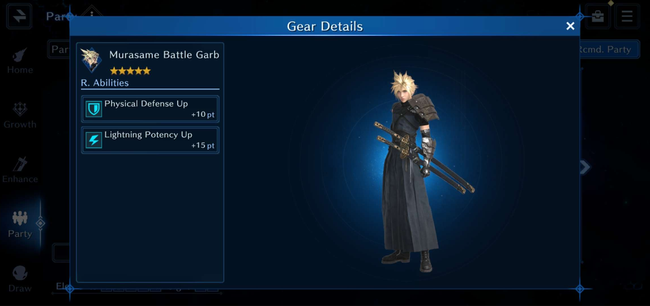
Costumes have added gameplay benefits too, so they’re enticing beyond just for cosmetic purposes. Cloud’s samurai-themed Murasame Battle Garb has the Physical Defense Up and Lightning Potency Up reinforcement abilities, so it’s a natural fit to pair with the Murasame because it enhances its Thunderstrike core ability and gives Cloud more survivability. Once a stamp card has been completed, all subsequent stamp cards guarantee a 5-star weapon on their 6th and 12 stamps.
Finally, there is one more thing to consider about the gacha system in Ever Crisis. I mentioned something about a system that offsets the 0.10563% chance of receiving a specific desired 5-star version of a weapon.
In stamp banners, people can set a wishlist for five 5-star weapons they are aiming to get. These will have a higher chance to appear on the off-chance that a SSR weapon does show up in a 10-roll alongside the featured weapons on the banner. I’m not entirely sure what the values are on their increased probabilities but hey, it’s higher than 0.10563%.

That is pretty much everything I’ve learned in the brief time I spent with the Final Fantasy VII: Ever Crisis closed beta. There are several features I wasn’t able to check out because I didn’t want to grind to unlock them, like enhancing materia is locked behind completing the 10th floor of the Tower, and that’s a tall order. There is a grayed-out Season Pass button in the options menu, so expect a battle pass of some sort. For those planning to reroll when the full release rolls out, there is a Delete Account option so you won’t have to download it again and again from scratch to reroll. There’s still no announced release date for Ever Crisis at time of writing and you can keep an eye on its pre-registration milestone rewards here.
Honestly, I enjoyed my time with Ever Crisis so far. It has a lot going on and I love games that let me tinker around with its gameplay mechanics extensively. I’m very interested in seeing how the other Compilation of FF7 titles are going to be presented in it and what playable characters they will introduce. The closed beta only had Cloud, Barret, Tifa, Aerith, Red XIII, Zack, Glenn, Lucia, and Matt for now. While I do have a few minor concerns on what the day-to-day experience will end up being, I’ll definitely give the full game a shot and stick with it the best I can. The closed beta test made a solid case for Ever Crisis to me, so I guess… mission accomplished.